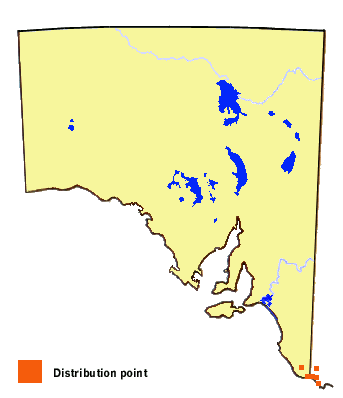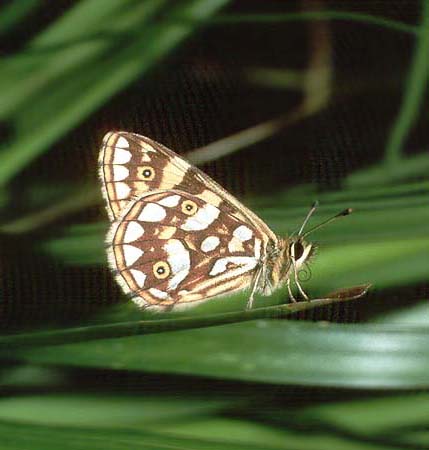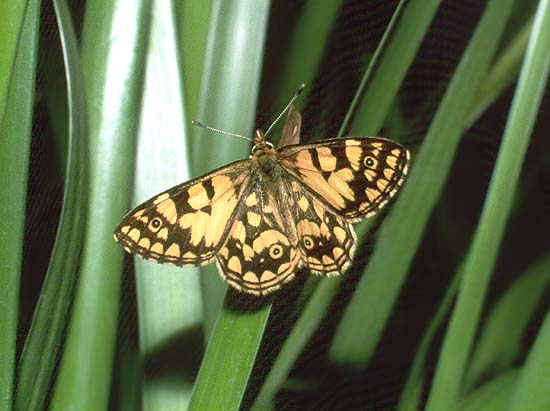-
Larval Food Host
-
Native grasses with small, soft leaves, including
Microlaena stipoides (weeping rice-grass),
Poa species including P. labillardieri (tussock grass)
and P. meionectes,
and probably Tetrarrhena species (rice-grasses) (Poaceae).
The larvae feed on the hostplant leaves.
-
Eggs
-
Small, pale green, thin shelled, nearly spherical, flattened basally, smooth and shiny
but with a series of very fine, indistinct vertical ridges. Usually laid singly on the
hostplant, or sometimes on other plants or debris adjacent to the hostplant. Larval
development within the egg commences immediately after being laid, and larvae begin
to emerge in about 16 days in early autumn. When ready to emerge, the larva incompletely
cuts out a circular area at the top of the egg, leaving a small uncut portion, and then
pushes the top out like a hinged lid. The egg shell is then usually eaten by the larva.
-
Larvae
-
The first instar is initially pale yellowish or whitish green with prominent brown spiracles.
The head is large, shining, but very finely rugose, rounded, pale yellowish green, with some
short dark hairs. There are also some short black hairs on the body that are longer anteriorly
and posteriorly, and which are slightly knobbed at the ends. The hairs arise from a short,
simple raised protuberant smooth base. In the first instar, the head is not horned and the
rear end is not forked. After eating the green leaves of the hostplant, the larvae gradually
turn green and acquire indistinct whitish, longitudinal subdorsal and lateral lines, and the
head becomes noticeably olive green coloured. The area behind the head remains pale yellowish.
Feeding normally occurs at night, and initially the larvae will usually remain on the hostplant
near where they eat, often covering themselves with the remains of their dung pellets. However,
some larvae will move around, particularly towards the base of the hostplant, moving back up to
the outer parts of the hostplant at night to feed.
The second instar is green with a dark green longitudinal dorsal line, and pale yellow longitudinal
subsorsal and lateral lines. The head is green and rounded on top. The rear end has a short, pale
coloured forked tail, typical for the Satyrinae.
The mature larvae are long cylindrical shaped, tapering anteriorly and posteriorly,
slightly flanged laterally, about20 mm long. They occur as various colour polymorphs,
being various shades of green or brown, with a dark dorsal line edged pale yellowish,
a pale yellowish lateral line, and variable dark or pale subdorsal lines.
In brown larvae, there is an additional longitudinal subdorsal row of dark spots.
The body and head are without long hairs, but bear numerous pointed secondary setae
that are set on simple, protuberant bases. The head is large, very finely rugose,
rounded (without horns), with some fine darker markings. The rear end has a short fork,
yellowish, with the tips pink coloured.
The immature larvae nibble the leaf edges of the hostplant, but later instars devour
the entire leaf and also other soft green parts of the grass. Early instar larvae
tend to remain exposed on the hostplant, but later instars hide around the base of
the hostplant coming out at night to feed. The latter larvae emerge soon after sunset
to climb the hostplant, and move very slowly. If disturbed while feeding, the larvae
will release their hold on the grass and drop to the ground, remaining rigid for some
time in whatever position they were in at the time of the disturbance. If the grass has
a few dead leaves, then both green and brown larvae are extremely well camouflaged on
the hostplant and very difficult to detect. The larvae feed slowly through winter and
spring, and pupation takes place during late summer and early autumn. Larvae can
withstand snow and freezing conditions during winter.
-
Pupae
-
Small, stout, 9-10 mm long, with a roughened surface, rounded posteriorly, wedge shaped
anteriorly with a pair of widely spaced short horns, there is a thoracic keel, and the
pupa is ridged laterally at the thorax-wing junction, the wing joints are protuberant,
and there are subdorsal pairs of low abdominal protuberances, the more posterior pairs
(segments 4-7) are joined by transverse ridges. The pupae occur in various shades of brown.
The pupa is suspended head downwards by a cremaster.
The pupal stage lasts about three weeks.
-
Flight Period in South Australia
-
Only one brood a year. In South Australia the butterfly has only been seen to fly
in March and April. In the adjacent areas of western Victoria and the Grampians,
the butterfly has an extended flight period from late January to late April with
the bulk of the butterflies flying during February to mid-April. Butterflies tend
to emerge later near the coast than those in the cool elevated areas. It tends to
fly later in the season than the similar
Oreixenica kershawi kanunda.

-
Distribution
-
In South Australia, this butterfly was only known to occur in the Piccaninnie Ponds Conservation
Park in the Lower Southeast Region of the state, but very recently it has also been seen by
B.T. Haywood to occur in the forests between Mt Burr and Mt Gambier. Historically, its distribution
may have been similar to Oreixenica kershawi kanunda. The local subspecies of the butterfly
is presently grouped with the widespread mainland subspecies herceus. The local subspecies
also occurs in the adjacent parts of western Victoria, particularly along the pristine portions
of the Glenelg River and its tributaries, but does not become common until the Grampians. Elsewhere,
the subspecies herceus exists throughout the cooler, damp areas of the Great Dividing Range
in Victoria, extending through the ACT to northern NSW. Three other subspecies occur in Tasmania.

-
Habitat
-
In South Australia, the butterfly occurs either in damp shady forest areas or in the cool,
damp shady silky tea-tree (Leptospermum lanigerum) - Poa wetlands adjacent
or near to the coast, which do not dry out over the hot summer months, and where its larval
hostplant grass in the understorey remains in a green condition all year round.
Elsewhere in Australia, the butterfly occurs in cool (less than 20 C average annual maximum),
damp shady woodland and forest areas receiving more than about 700 mm of annual rainfall.
-
Conservation Status in South Australia
-
Vulnerable in South Australia, with the butterfly being at the extreme western limit
of its range. In the eastern states, particularly in elevated areas, the butterfly
can be locally very common.
-
Threats
-
At present, the butterfly is reasonably secure within its South Australian locations,
although any major catastrophe at the locations would likely see the demise of the
butterfly within South Australia.
-
Conservation Strategy
-
Ideally, a broader vegetation corridor should be established between the Piccaninnie
Ponds C.P. in South Australia and the adjacent Lower Glenelg N.P. in Victoria.
It is likely there is already communication between the depauperate colonies of
O. lathoniella within the two parks. An attempt could be made to (re)introduce
the butterfly into the same habitats as Oreixenica kershawi in South Australia.
Clearance, drainage and degradation of the remaining silky tea-tree/Poa wetlands
in the Lower Southeast needs to totally cease, and these wetlands need to be fenced off
from grazing domestic animals. Draining of the wetlands puts the habitat under stress
in summer, often causing the understorey grass to dry off, to the fatal detriment of the
larvae of this butterfly and its relative O. kershawi. Where possible, the exotic
blackberry and Coprosma should be controlled or removed from these wetlands.



